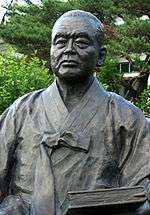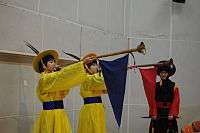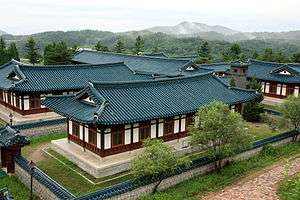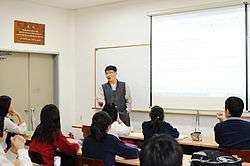Korean Minjok Leadership Academy
Korean Minjok Leadership Academy (KMLA; Korean: 민족사관고등학교, Hanja: 民族史觀高等學校; Minjok Sagwan Godeunghakgyo, lit. '"People's History High School"')[2][3][4][5][6] is a co-educational, independent boarding high school near the town of Hoengseong, Gangwon, South Korea, 120 kilometers (75 mi) east of Seoul at an elevation of 600 meters (1,900 feet). Located on 1.27 square kilometers (314 acres), it is one of the largest institutions in terms of contiguous area in the nation. One of the most selective secondary boarding schools in South Korea, KMLA is reputable for the placement of its graduates at eminent universities.[7][8][9] KMLA is a member of the G20 Schools group.[10]
| Korean Minjok Leadership Academy 민족사관고등학교 | |
|---|---|
| Location | |
| , Gangwon province | |
| Information | |
| Type | Private, boarding |
| Motto | 민족 주체성 교육 (English: Deep Awareness of the Heritage of Our People) |
| Established | 1996 |
| Headmaster | Jean-Gon Cheong, Ph. D. |
| Grades | 10–12 |
| Gender | Co-educational |
| Enrollment | 459 (2012[1]) |
| Student to teacher ratio | 7:1 |
| Campus size | 1,274,350 square metres (314.90 acres) |
| Campus type | Rural |
| Slogan | Korea in Heart, World in Mind |
| Website | english |
| Korean name | |
| Hangul | |
| Hanja | |
| Revised Romanization | Minjong Sagwan Godeunghakgyo |
| McCune–Reischauer | Minjong sagwan kodŭnghakkyo |
History
School founder Choi Myung-Jae found reason in establishing KMLA upon a visit to England's Eton College in 1977, feeling the need for an institution of high character to nurture future global leaders in Korea.
Choi received government permission to establish the school in 1993. The first headmaster and faculty were appointed on 1 March 1995, and the school received its first students a year later. The gym was completed in December 1996, and Dasan Hall (one of the two main school buildings) was completed the following year.
The school's `English-only policy' (EOP) was established in January 1997 and was applied to all areas of the school except a few non-English classes. In the same year, Choi was appointed school director. In 1998, the school's three step education policy of teaching-discussion-writing was institutionalized, the first elections for the student council were held, and the Minjok Herald was first published. In 1999, the graduation of the first wave was held and the twelve-floor dormitory was completed. In 2000, Choi Kyung-Jong was appointed director.
In 2001, the school was certified as an Educational Testing Service AP test center and designated as an experimental independent private school by the South Korean government. In 2002, founder Choi Myung-Jae took office as the fourth headmaster. In 2003, the school held its first mathematics competition for middle school students, and the former minister of education, Lee Don-Hee was appointed headmaster that August. In 2004, the school inaugurated the Global Leadership Program for Students (GLPS), established an individual research program, and achieved certification to administer the SAT and PSAT.
In 2007, KMLA was highlighted by the US College Board as a World Best School in the Advanced Placement Program in seven subjects expanded from four subjects the year before—calculus, chemistry, microeconomics, macroeconomics, physics, and statistics. That same year, the Wall Street Journal listed the school's international program at No. 32 among schools that matriculated students to eight most-selective American colleges and universities.[8] The school has an average SAT score of 2260.
With the commencement of the new semester in 2008, Cheong-il Yoon, Ph.D., former dean of education at Seoul National University, assumed the headmastership. Under his leadership, reforms have been initiated, namely the increased and systematized effort to fund raise as well as the plan to make international teachers comprise 30 percent of its faculty. In 2011, the KMLA's first music concert was held.
Description
School Motto
Endowed with national pride in heart, and our fatherland's bright future in mind, let us study not for the sake of personal gain but for the sake of learning itself. Let us not choose a career based on thoughts of personal advancement but choose a career based on talents and aptitude. Such is my true happiness, tomorrow's bright fatherland, and a better world for all.
KMLA School Song
The school song is written in the form of sijo, folk song, and march. The school song consists of the school history and eventual goal of the school. Singing the song in morning assemblies and school events, students promote school pride and community spirit. Every Monday at the end of the morning assembly, all students and teachers stand up and sing the school song accompanied by the KMLA Orchestra or the Minjok Orchestra.

Description
Some of KMLA's characteristics and policies are as follows:
- Support for the teachers' academic research;
- Individual college counseling for students regardless of field;
- Daily physical training (morning exercise) in forms of Taekwondo and Kumdo;
- Promotion of classes and clubs for Korean traditional music and arts, including Samul Nori, Daegeum, and Gayageum;
- Individual Research (IR) hours granted within the regular curricula;
- Unsupervised examination policy;
- Wide variety of clubs including athletic teams, orchestra, school bands, community service groups, student publications, craft workshop sessions, and peer tutoring.
Admission Process
The admission process of KMLA goes through three steps — a first round selection of students is admitted based on application forms containing school grades, essay, and extra curricular activities. Selected students then go through an interview, and a physical test (4 km track); those who achieve generalized top evaluations are admitted.
Achievements
Throughout school history, KMLA students have received awards in international competitions such as in Olympiads in science, mathematics, debating and philosophy. Approximately one-thirds of the graduates enroll in foreign universities, mostly in the United States. The annual cost of attending KMLA is estimated to be $15,800 (2008).[11]
School life
KMLA students are enrolled either on the domestic track (Minjok field) or on the international track, depending on their plans for college application. Beginning in 2008, KMLA has begun to select students without differentiation by separate tracks, enabling the students to make their decisions concerning college during their high school years without unnecessary pressure.
In the beginning years of KMLA, the entrance exam allowed only 20 to 30 passing students, but has steadily increased the number of new students from 2003. From 2004–2009, the school admitted 150 students. However, corresponding with the plans of the school to increase its size, an enrollment of around 160 students in 2010 marked the most recent entry of students into the school.
Although the largest number of KMLA students are from Seoul and Gyeonggi-do, students come from all over the country, as far as Jeju. Moreover, numerous students from nations abroad, including China, Canada, France, Japan, Australia, and the United States, have been granted admission.
School Policies
Morning Assembly
All students and teachers gather at the school gym every Monday on the 1st period for the weekly Morning Assembly. The assembly begins with the 의례단 entering the gymnasium, followed by the teachers. Students who are Korean citizens must sing the national anthem with honour and respect to the Korean flag. Every week, a teacher or student (sometimes both) give a speech on various topics, the most popular topic being school life. The two school orchestras, KMLA orchestra and Minjok Orchestra, take turns in performing the school song and national anthem during the assembly. During the Award Ceremony, awards are given to students who have performed well in contests in and out of school. The president of the Legislative Council also gives a small brief of the week's school events.
The English-Only Policy (EOP)
All students are required to speak in English from eight in the morning to six in the evening, Monday to Friday. Students who get caught violating the EOP twice in a week receive two penalty points. The purpose of EOP is as follows:
English is only a tool to raise Korea to the highest level by accommodating diverse civilizations in accordance with Korean tradition. English Only Policy is merely a means, not an end in itself.
Teachers are also recommended to give their lectures in English.
Uniforms
During all classes and the Honjung practice, students are required to wear the school uniform. The most common uniform is the modernized hanbok, called saenghwalbok. Students wear this to most classes and are free to choose from up to a dozen different colors. There are seasonal variations for summer, winter, and spring/fall, varying in thickness, sleeve length, and fabric. All teachers wear hanbok too, freely chosen though.
During official school ceremonies such as the Morning Assembly, and Entrance/Graduation Ceremony, students are required to wear a formal, rather traditional uniform called yebok. There are two types of yebok, one for the summer season and one for the winter.
Honjung
Honjung (혼정, 昏定) is a traditional Korean practice during which scholars reflect on the day and pay gratitude to their parents. Honjung in KMLA is half an hour long in the evening ritualized in assembly dormitory rooms. Students direct their thanks to 'dorm parents', or dormitory supervisors, in proxy of their parents. Once the dorm parent finishes his or her moral discourse and announcement, all the students bow to the dormitory inspector. The afterward time is used to make announcements and to share celebratory events, like birthdays.
Minjok Peer Tutoring
Minjok peer tutoring is an effort in which students share their specific strengths with one another through one-on-one tutoring. The MPT program is designed to bring together students with strengths in different fields (math, science, humanities) to ensure a more rounded education of the entire student body. Students who wish to receive MPT register as "tutees" along with their desired subjects and the students who wish to teach register as "tutors" with their preferred subject to teach. Some students prearrange their lessons with their tutors, but for those who cannot, the MPT managers arrange the tutors and the tutees allowing efficient progress.
Education
School Year
Like other Korean high schools, the school year at KMLA officially begins in March and ends in February. Likewise, the official "entrance ceremony" of freshmen is in March, and the official "graduation ceremony" of seniors is in February. However, all students, including freshmen, are required to begin their first semester of the year in late January (During this month, sophomores and seniors attend classes, and freshmen go through an 'orientation' period where they get accustomed to the school), and seniors are allowed to leave the school in December.
Classes
Every student in KMLA belongs to one of four fields – domestic humanities, domestic natural sciences, international humanities, and international natural sciences. The division between fields are not as strict as in other Korean schools; students are not admitted proportionate to each field, students are free to change fields every semester, and except for Korean Language Studies, English, and Mathematics, students are free to choose whatever class they wish to take.
Some examples of classes include:
- SAT classes, such as SAT Physics, SAT Chemistry, and SAT Biology
- AP classes, such as AP Physics, AP Chemistry, AP Biology, AP Macro/Micro Economics, AP US History, AP US Government and Politics, AP Psychology, AP European History, AP World History, AP Computer Science, AP Environmental Science, AP English Language/Literature, and AP Comparative Politics
- Classes that follow the Korean curriculum, such as Physics I/II, Chemistry I/II, Biology I/II, Earth Science I/II Korean History, Law and Politics(법과 정치), Ethics, Cultural Science(사회문화),
- Advanced Classes, such as Advanced Physics, Organic Chemistry, Cellular Biology, Molecular Biology, and Positive Psychology
- and IR(individual Research) classes.
Extracurricular Activities
Over hundreds of extracurricular activities are available at KMLA. Examples include the mock trial club, Sock Sack Im (peer-counseling club), Through the Lens (photography), Daechita (Korean Music for Royal Palace Ceremonies & Rituals), Samuchim ( Samul nori), Minjok Orchestra, New Age of Ballad and Synergy (ballad), FITM and PLZ (rock), Rhyme Factory (hip hop), the school branch of Amnesty International, Minjok Herald (school English journal) and Bulhui (school Korean journal), English Debating Society (a.k.a. EDS), ECORUM (economics), Apple Pie (astronomy), and Life is Drama (drama), to name a few.
Student Clubs
- KMLA Orchestra
KMLA Orchestra is a symphonic orchestra composed of more than sixty students, and performs wide variety of music, such as symphonies, serenades, and overtures. KMLA Orchestra has held several concerts at Hoengseong Community Center, Bobas Hospital, Wonju House of Angels, and Asan Hospital.
- Through the Lens
Through the Lens (TTL) a photography club. The club has a club website to share members' photographs. Also, it holds inner-school exhibitions twice a year and outer-school exhibition once a year. In 2010, TTL's exhibition was reviewed by many notable Korean photographers.
- Minjokers
Minjokers is the baseball club. About a dozen students are picked each year through an evaluation. In 2010, the team won gold at the Gangwon baseball championship. //Its name was changed into KMLA Baseball
- Crossover
Cross Over is the official boys' basketball team. Crossover holds practices two to three times a week, and receives formal training from the coaching staff of a nearby professional league basketball team. It won the Gangwon State Championships in 2009, 2010, and the Gangwon State Club Basketball Championship in 2010.
- Game Over
Game Over is the official girls' basketball team. Game Over members have practice everyday during the weekdays, with an additional two hours practice twice every week. Under the instruction of vice headmaster Dr. Han, Gameover has won public acclaim and acknowledgement as the five time running Gangwon State Champion.
- Daechita
 Daechita
Daechita
Daechita is a Korean ensemble that practices Korean royal music played just before the King's appearance. Nine members are accepted during freshman year and perform daechita at the beginning of all major school assemblies, including graduation, freshman-welcoming ceremony and at the official school festival.
- English Debate Society (EDS)
The club engages in English debates both in and out of the campus with motions chosen from a variety of topics. The members have represented Korea at the World Schools Debating Championships (WSDC) held annually. In 2009, a team won the European Schools Debating Championships (ESDC) tournament held in Stuttgart,Germany. In 2011, teams from EDS have won a number of tournaments in Korea, namely the National Schools Debating Championships (NSDC) as well as the Gwangju Youth Debating Championship.
- KREEN
KREEN is a club devoted to environmental awareness campaigns. The club has held numerous campaigns on and off campus against wasteful water usage and electricity. Under the motto, "Save energy save earth", the club works in cooperation with the Ministry of Environment. //Do not exist in 2017
- Minjok Herald
The official student English magazine, the Minjok Herald is a quarterly publication distinguished for its feature section. Entirely student-run, the Minjok Herald is a member of the National Scholastic Press Association.[12]
- Mock Trial
In Spring 2010, the KMLA mock trial team won the Mock Trial Global competition held by Handong International Law School, and went on to defeat Team Australia at the second annual Korea-Australia Mock Trial Friendly Match. Another team at KMLA placed first runner up at the annual Korea Mock Trial Association Summer Championship, co-hosted by Korea Mock Trial Association and Yale Law School.
- Stars On the Stage
Stars On the Stage (SOS) is a musical club in KMLA. SOS performs ten-minute musical at the annual school music concert. In 2011, at the first Minjok Music Concert, SOS performed the musical <Hairspray>. In 2012, SOS performed the musical <Fame>. In 2013, SOS had a performance named <Better Together>, which used songs from GLEE and High School Musical. KMLA financially supports SOS by paying lesson fee of outside musical instructor. //Do not exist in 2017
- Play ball
'Play ball' is a soft ball club in KMLA. About 25 female students and 6 male student coaches actively participate in the practice in 2014. There are two sub-group in this club: one for softball and the other for T-ball. In 2013, Play ball won the T-ball game against Korean Science Academy (20:7). It is the representative softball team of Gangwon-do. In 2014, Play ball ranked second place of T-ball in Gangwon-do. //Do not exist in 2017
- ApplePie
Apple Pie encourages more students to have interest in astronomy and deep sky objects. Simultaneously, ApplePie try to make an open space for students interested in space to interact and exchange ideas with each other.
- THE SCENE
THE SCENE is a musical club founded in 2017. After the extinction of Stars On the Stage, THE SCENE became the only musical club in KMLA. Unlike SOS, THE SCENE's production performs full musicals which are very popular for public. In 2018, THE SCENE is planning to perform full scores of 'Phantom of the Opera.' No financial aid from school was supported.
above this, about 90 clubs exist in KMLA.
Student Government
The purpose of the student council is to give students the opportunity to experience and take part in democracy during their school years. It leads students to develop creative leadership while experiencing both the tripartite political system and the duties as a representative. The student council consists of three main branches: executive, legislative, and judicial. There are fourteen departments that support and work with the three councils.
- Executive Council
- Legislative Council
- Judicial Council
The members of each council are elected every semester by popular vote. The Executive and Legislative Council consists of five members – one president and two vice presidents who are 11th graders, and two 10th grade members. The judicial branch consists of three members – one president, and two vice presidents. The 22nd student council was elected in September 2016.
The judicial branch manages the school court, where the students who violated the school regulation go every Thursday. The branch also tests the validness of the students' defending speeches, which if true can be excused from punishment. The amount of penalty points the students receive from breaking the school regulation depends on the judicial branch's judgments. The judicial branch also cooperates with other two branches, the executive branch and legislative branch, to help amend problems in school regulations or systems.
The fourteen departments are: The Department of School Event Management, the Department of School Guidance, the Department of Food and Nutrition, the Department of Justice, the Department of Finance, the Department of Broadcasting, the Department of Library Management, the Department of Audit and Inspection, the Department of Public Information, the Department of EOP, the Department of School Environment, the Department of Education, the Department of School History, and the Department of Physical Education.
School campus
- Dormitory: The dormitory is a 12-story building including student rooms, study hall, a cafeteria and bakery. 3 students share one room with individual beds and desks. Rooms are connected with a hallway and share a common bathroom.
- Minjok Cultural Center: Minjok Cultural Center is the center of Korean cultural education. Learning Korean traditions including Daegum, Gayageum, and Samul nori, students establish their identity as proud Koreans.

- Education Building: Education Building consists of two buildings, which are Chungmu-building and Dasan-building (above two buildings being named in tribute to two prominent figures of Korean history). There are science labs, a library, auditorium, computer labs, recording studios and practice rooms, a dance studio, as well as the bulk of teachers' individual laboratories.

- Gymnasium: Gymnasium is an indoor sports building with a gymnastics room in the basement. Such facilities allow students to enjoy many sports, despite the isolated location of KMLA, such as basketball, table tennis, Taekwondo, Kumdo, Volleyball, etc.
- Korean Archery Field :Practicing Korean traditional sports archery in this field, students train sound body and sound mind and pride for their nation.
- English Education Building Along with the English Only Policy, the English Education Building is solely devoted to English education. Many English teachers including several native speakers have laboratories in this building.
- Track Field : KMLA has a 400m track capable of international 2nd field and track event. Inside the track, there is a lawn soccer field with a few sprinklers. A tennis court and basketball court are located beside the track field.

Athletics
Every morning, students participate in morning exercise from 6:30 to 7:00. 10th graders either participate in Kumdo and Taekwondo, and all KMLA students, by the end of their first year, is officially registered in the Korean Kumdo Association or the Korean Taekwondo Association as an athlete. 11th graders are given a more diverse set of choices, including volleyball, softball, and jogging.
Physical Education classes are mandatory for all three years. 10th graders learn Korean Archery and Golf for a semester each. 11th graders can choose from basketball, soccer, and dance sports. 12th graders may choose from volleyball or table tennis.
Students can also participate in sports clubs The following is a list of a few:
- Badminton
- Baseball
- Basketball
- Boxing
- Equestrian
- Football (soccer)
- Golf
- Korean Archery
- Kumdo
- Rowing
- Softball
- Swimming
- Table Tennis
- Taekkyon
- Taekwondo
- Tennis
- Volleyball
- Water Polo
References
- "KMLA Enrollment". Korean Minjok Leadership Academy. Retrieved 26 July 2013.
- "New Pledge of Allegiance to Reflect Growing Multiculturalism". The Chosun Ilbo. South Korea. 18 April 2011. Archived from the original on 20 April 2011. Retrieved 20 April 2011.
The military has decided to omit the word 'minjok,' which refers to the Korean race, from the oath of enlistment for officers and soldiers, and replace it with "the citizen." The measure reflects the growing number of foreigners who gain Korean citizenship and of children from mixed marriages entering military service.
- Lee, Jin-seo (2016). North Korean Prison Camps. Radio Free Asia. p. 26. Retrieved 3 March 2016.
Internet broadcast of Uriminzokkiri (Our Race Alone), an official North Korean media outlet...
- Doolan, Yuri W. (June 2012). "Being Amerasian in South Korea: Purebloodness, Multiculturalism, and Living Alongside the U.S. Military Empire" (PDF). The Ohio State University. p. 63. Retrieved 3 March 2016.
- Em, Henry H. (2013). The Great Enterprise: Sovereignty and Historiography in Modern Korea, Part 2. p. 77.
As noted earlier, the word minjok (read as minzoku in Japanese) was a neologism created in Meiji Japan. When Korean (and Chinese and Japanese) nationalists wrote in English in the first half of the twentieth century, the English word they generally utilized for minjok was 'race.'
- Choi, Hee-an (2015). A Postcolonial Self: Korean Immigrant Theology and Church. p. 24.
The word minjok (민족,民族) translates as race.
- Dillon, Sam (27 April 2008). "Elite Korean Schools, Forging Ivy League Skills". New York Times. Retrieved 19 September 2013.
- Gamerman, Ellen (28 December 2007). "How the Schools Stack Up". Wall Street Journal. Retrieved 19 September 2013.
- "KMLA Admissions at Universities Abroad". Korean Minjok Leadership Academy. Retrieved 25 July 2013.
- "KMLA Achievements". Korean Minjok Leadership Academy. Retrieved 25 July 2013.
- Finch, John; Kim, Seung-kyung (2009). "Thinking Locally, Acting Globally: Redefining Traditions at the Korean Minjok Leadership Academy". Korean Studies. University of Hawai'i Press. 33: 124–149. doi:10.1353/ks.0.0028. Retrieved 19 September 2013.
Cost of attendance valued at KRW15,000,000, p.141; currency rate at time of article research, March 2008 was KRW947 = USD1
- "Membership Status Search at NSPA homepage as of 10 December 2012". Archived from the original on 15 December 2013. Retrieved 10 December 2012.
Further reading
External links
| Wikimedia Commons has media related to Korean Minjok Leadership Academy. |
- Official School Website (Korean)
- Website of the KMLA GLPS program in the history of science
- Official School Website (English)
- KMLA VR Campus VR campus map made by students,detailed inside of the school is open to the public.
